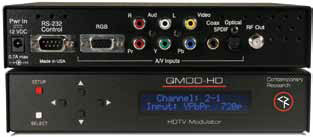Tune Up

Contemporary Research’s QMOD -HD Streamlines The Integration Of HDTV Broadband Solutions
COMPANY: Contemporary Research
HEADQUARTERS: Dallas, TX
SOLUTIONS: Contemporary Research responded to integrator demand for a commercial-quality, cost-effective HDTV modulator to enable in-house HD cable networks.
Starting several years ago, integrators repeatedly asked us for an alternative to distribution of HD video over Cat-5 wire and ethernet. Their reasoning was that cable TV broadcasts many channels of HD digital media over miles of standard coax cable, and that Contemporary Research (CR) makes HDTV tuners and could control displays over the RF. The logical conclusion would be for CR to create a commercial-quality, cost-effective HDTV modulator to enable in-house HD cable networks. Sites can:
- Distribute HD video from HD satellite/cable boxes so that any HD display or tuner could receive quality, open-access digital media.
- Broadcast digital signage as an HDTV channel so that one PC could deliver signage to all displays in the system.
- Insert any of the channels with existing cable feeds or “cut the cable” and create a custom mix of media and signage channels.
At the Buffalo Wings & Rings restaurant in Indianapolis, IN, Vinny Barber of AVI E-Consulting in Orlando, FL integrated 10 Contemporary Research QMOD-HD-HD units to feed 54 TV monitors.
QMOD-HD is a solution for any site that needs to distribute a few channels of high-definition content to many displays, and can take advantage of existing RF coax to carry the media. Commercial QMOD-HD solutions are rapidly expanding at corporations, casinos, sports venues, and churches around the country. In addition, QMOD-HD has also passed the test for professional HD applications, including:
- The Ford Center (host to Oklahoma City’s Thunder NBA team) is using QMOD-HD to broadcast their house channels, fed by their HD video system, taking the place of equipment that would have cost $15,000 per channel.
- A rural cable company is delivering HD channels to customers, using QMOD-HDs connected to Dish Network HD receivers to feed their Motorola commercial cable head end.
- The Winnipeg, Canada airport is using QMOD-HD to distribute data-driven signage to airport displays.
QMOD HDTV technology is opening new markets for AV systems integrators. Armed with three options for media distribution—HDTV, Cat-5, and ethernet, integrators have more choices to create new solutions.
QMOD-HD is an integrated HDTV modulator, consisting of several processes working together. It ingests analog VGA, component, S-video, or composite video and converts to digital video—the new QMOD-SDI, launched in May 2010, accepts HD/SD-SDI. Stereo, digital coax, or optical audio inputs are fed to the HDTV encoder, and the latter formats the digital video and audio into an MPEG-2 digital QAM IFF channel. An upconverter mixes frequencies with the base IFF channel to broadcast as channel 2-135, and the amplifier powers the channel up to 29 dB for distribution.
A daily selection of the top stories for AV integrators, resellers and consultants. Sign up below.

QMOD-HD is an integrated HDTV modulator, consisting of several processes working together.
QMOD-HD accepts any video input that is in standard HDTV format, including 1080i, 720p, 480p, and 480i at 59.94 Hz vertical frequency. For non-standard HD sources such as VGA, QMOD-HD is designed to work in tandem with a video scaler. There are several reasons for this: The scaler can format VGA resolutions to true HDTV signals; displays typically overscan HDTV video, so the scaler will often need to underscan VGA to compensate; and because the encoder’s processor does not have to “fix” non-standard video, the dual-processor approach delivers quality signage without motion artifacts, correctly presented on displays.
QMOD-HD integration is fairly simple, and several variations can be found in CR’s QMOD-HD Integration Tips publication on its website. As for distributing QMOD-HD channels, the good news is that digital QMOD-HD channels work easily with all existing cable distribution systems, even if they were designed in an analog era. In cases where the client needs a display control system, CR’s Display Control is easy to integrate, as it takes control of displays over the same RF coax that carries QMOD-HD channels.
Given these solutions, AV integrators will likely find that HDTV distribution is a natural extension for their business and their clients, and is easy to learn and apply.
Doug Engstrom is technical director at Contemporary Research.
